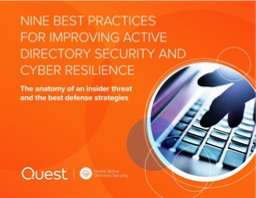Nine Best Practices for Improving Active Directory Security and Cyber Resilience
Upon discovering that someone has illegitimately accessed data on the network, IT managers initially believe that the threat came from outside.
But as recent, headline-grabbing data breaches demonstrate, a lapse in internal security, whether accidental or malicious, is often what enabled the attack to succeed, in spite of robust external security.
This e-Book explores how a typical insider threat unfolds and details nine critical security best practices that minimize the risk of the internal threat to the availability, confidentiality and integrity of AD.
Read More
By submitting this form you agree to Quest UK contacting you with marketing-related emails or by telephone. You may unsubscribe at any time. Quest UK web sites and communications are subject to their Privacy Notice.
By requesting this resource you agree to our terms of use. All data is protected by our Privacy Notice. If you have any further questions please email dataprotection@techpublishhub.com
Related Categories: AIM, Applications, Backups, Cloud, Collaboration, Compliance, Databases, Disaster Recovery, Email, ERP, Event Management, Malware, Microsoft Office, Network, SAN, Server, Service Providers, Software, VPN, Windows Server


More resources from Quest UK

Enterprise Backup and Recovery Made Easy
Protecting enterprise data in a complex IT environment is challenging, time-consuming, cumbersome and often incomplete. Backup and recovery technol...

The Definitive Guide to Sharepoint Migration ...
If I've learned anything in more than a decade of working with SharePoint, it's that migration is more than moving bits between servers. When I joi...

Top Seven Reports for Supporting a Growing Vi...
IT environments are more dynamic than ever, and having more users working from home introduces new vulnerabilities. You undoubtedly want to take fu...